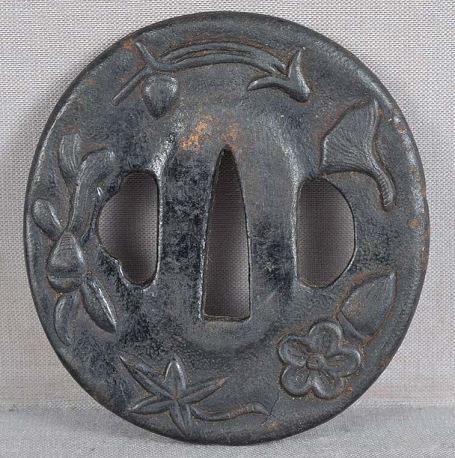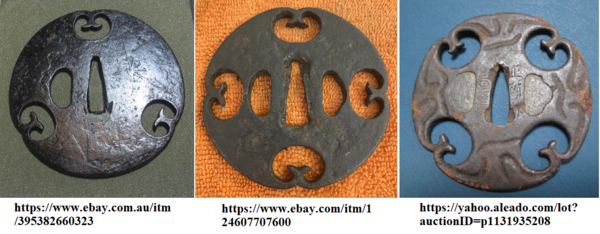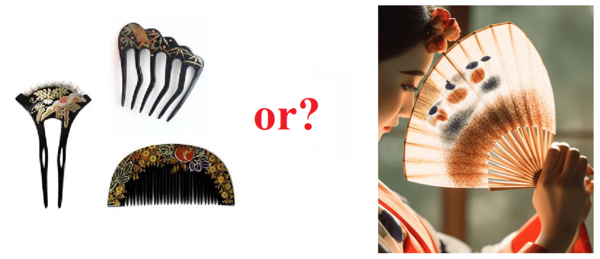-
Posts
2,892 -
Joined
-
Last visited
-
Days Won
65
Content Type
Profiles
Forums
Events
Store
Downloads
Gallery
Everything posted by Spartancrest
-
I had another look at that particular museum and found this : https://spencerartap...-search#/object/4788 Interesting Shoami design - I wonder if the Saotome school would have other ideas on the subject? https://spencerartap...-search#/object/4727 What do we think of the possibility this guard is by the Sōten School ? [highly unlikely IMHO ]
-
That is what I thought - never seen that before, not sure I like it much as a design - looks like something went wrong [That's what happens when you mix Yoshiro with Kinai ]
-
Yes there are models made see this thread:
-
The Spencer Museum of Art in the University of Kansas has a nice modest collection of tsuba - around 250 https://spencerartap...#/search/works/tsuba But I don't know who is describing the collection or how much they know about the more common schools of artists. Kinai School Description: Tsuba, radish and leaves pierce work. [ Not even close!] https://spencerartap...-search#/object/4756 https://spencerartap...-search#/object/4888 A cast copy [very common] see https://www.ebay.com.au/itm/226138221756 https://spencerartap...-search#/object/4836 Description: Tsuba, two leaves (blood stain corrosion) [clearly Kinai school design, "Blood stain corrosion" - how do they make that conclusion?] https://spencerartap...-search#/object/4818 Description: Tsuba, shibuichi nanako - kiri and passion flowers and leaves. Then they go on to say made of Iron - obviously Sanmai construction. Wrong descriptions are not restricted to just this museum of course - you need to be vigilant and keep your eyes open though.
-
I know we are talking almost microscopic details here but I can't help noticing the nunome scoring has skipped over the petals in one segment. Early type of work or a rushed job? [I think OLD - IMHO] What could have caused this? Tagane-ato gone wrong?
-
Jean, I don't like those two pins on the rim. I wish museums would use softer materials or at least restrict possible damage by using the nakago-ana. I found the same guard here https://searchcollec...8d3b0a22d131ed&idx=2
-

Tsuba in everyday objects - the culture of Tsuba
Spartancrest replied to Spartancrest's topic in Tosogu
https://spencerartap...-search#/object/3290 Is it just me or do you think the comb teeth could do with a clean? -
Well Peter I took your advice: Just to set the record straight. To be honest I never thought Amazon would take it on board
-

Trouble with Trivets episode- "Scottie, Beam me outta here"
Spartancrest replied to Curran's topic in Tosogu
Years ago I bought these sizzle plate tsuba - the set was 2,000 yen, I guess you could use them as trivets ? About saucer size. Set of coasters going on ebay https://www.ebay.com.au/itm/201551561416- 1 reply
-
- 2
-

-

-
Another from a Yahoo auction in the past.
-
Yes it is a cast copy, a lot of cast examples have been highlighted with touches of gold - it is a way of suggesting they are older than they really are. Another like yours here: https://www.trocader...d-TSUBA-forest-items Both examples have not been mounted. Another image here from some old source back in 2015: I would not count on any "sound" made by striking the guard, that is more myth than fact, imagine if you will how a sukashi guard would "ring" - not at all, even if hand forged. Also you might realise bells are cast yet they certainly ring.
-
-
Friedrich Wilhelm Nietzsche (15 October 1844 – 25 August 1900) Just how old are you Peter !!! ?
-
I have to report the first "review" of the new book. Amazon Book Review Reviewed in the United States on 17 July 2024 "A lot of work went into the book but in heavens name why are the pictures in black & white? Much of the detail and beauty of the tsubas is lost without color photos." Well two things 1. The images were originally in B&W and date from around 120 years ago - so should I have used AI to colour them? [It is a historical record not a coffee table book!] 2. There is no 's' on the end of "tsuba" There is always the option to return the book to Amazon - they have a thirty day policy and I quite like the idea that they don't get to make their exorbitant profit.
-
Hi Jake, I just found this Heianjo version https://www.jauce.com/auction/u1106343889 The condition is not perfect, the inlay is a little haphazard. It might "re-list" ?
-

Tsuba in everyday objects - the culture of Tsuba
Spartancrest replied to Spartancrest's topic in Tosogu
Deer skin tobacco pouch with "tsuba" decoration: https://www.jauce.com/auction/f1145159920 -

Tsuba in everyday objects - the culture of Tsuba
Spartancrest replied to Spartancrest's topic in Tosogu
-
Jake is right the tsuba looks perfectly correct, just a little tired - not surprising when it could easily be three hundred years old. [I won't look that good in that time span - in fact I don't look so good now!] Some variations on the design here- https://www.aoijapan.com/tsuba-mumei warabite/ https://www.ebay.com.au/itm/395382660323 https://www.ebay.com/itm/124607707600 https://yahoo.aleado...uctionID=p1131935208 https://japaneseswor...i-koshirae-complete/ There is one in the Cleveland Museum of Art [possibly by Kaneiye, but his signature was often copied] https://www.clevelandart.org/art/1919.515 https://www.ebay.com.au/itm/156312864300 https://www.ebay.com/itm/285897197391
-
Highly contagious and no vaccine either! [The only thing to slow the spread is an empty wallet!]
-
They are all beautiful pieces - I really like the Fuji san one
-

Tsuba in everyday objects - the culture of Tsuba
Spartancrest replied to Spartancrest's topic in Tosogu
Probably useful with this bottle of Saké - - https://rakusake.com/product/detail/658 or this 21 year old Shōchū - https://www.jauce.com/auction/t1139222519 Bottoms up! 乾杯 -
It doesn't mean much but the design turns up under a "Fan tsuba" Google search - it is like a lot of art, all in the interpretation of the observer.
-
-
So close except for the sekigane - the slight difference in size would make a good daisho. Great spotting Peter!
-
Something for formal attire - https://www.ebay.com/itm/305038903971 The description says Chinese but I think they are modified menuki and therefore Japanese. Do people still wear cufflinks?















